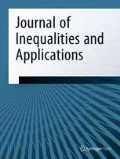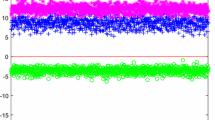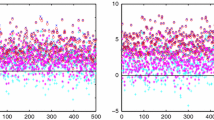Abstract
A lower bound and an upper bound for the spectral radius for nonnegative tensors are obtained. A numerical example is given to show that the new bounds are sharper than the corresponding bounds obtained by Yang and Yang (SIAM J. Matrix Anal. Appl. 31:2517-2530, 2010), and that the upper bound is sharper than that obtained by Li et al. (Numer. Linear Algebra Appl. 21:39-50, 2014).
Similar content being viewed by others
1 Introduction
A real order m dimension n tensor \(\mathcal{A}=(a_{i_{1}\cdots i_{m}})\), denoted by \(\mathcal{A}\in R^{[m,n]}\), consists of \(n^{m}\) real entries:
where \(i_{j}=1,\ldots,n\) for \(j=1,\ldots, m\). A tensor \(\mathcal{A}\) is called nonnegative (positive), denoted by \(\mathcal{A}\geq0\) (\(\mathcal{A}>0\)), if every entry \(a_{i_{1}\cdots i_{m}}\geq0\) (\(a_{i_{1}\cdots i_{m}}> 0\), respectively). Given a tensor \(\mathcal{A}=(a_{i_{1}\cdots i_{m}})\in R^{[m,n]}\), if there are a complex number λ and a nonzero complex vector \(x=(x_{1},x_{2},\ldots,x_{n})^{T}\) that are solutions of the following homogeneous polynomial equations:
then λ is called an eigenvalue of \(\mathcal{A}\) and x an eigenvector of \(\mathcal{A}\) associated with λ [1–6], where \(\mathcal{A}x^{m-1}\) and \(x^{[m-1]}\) are vectors, whose ith entries are
and \((x^{[m-1]})_{i}=x_{i}^{m-1}\), respectively. Moreover, the spectral radius \(\rho(\mathcal{A})\) [7] of the tensor \(\mathcal{A}\) is defined as
Eigenvalues of tensors have become an important topic of study in numerical multilinear algebra, and they have a wide range of practical applications; see [4, 5, 8–21]. Recently, for the largest eigenvalue of a nonnegative tensor, Chang et al. [2] generalized the well-known Perron-Frobenius theorem for irreducible nonnegative matrices to irreducible nonnegative tensors. Here a tensor \(\mathcal{A}=(a_{i_{1}\cdots i_{m}}) \in R^{m,n}\) is called reducible, if there exists a nonempty proper index subset \(I\subset N\) such that
If \(\mathcal{A}\) is not reducible, then we call \(\mathcal{A}\) irreducible.
Theorem 1
(Theorem 1.4 in [2])
If \(\mathcal{A} \in R^{[m,n]} \) is irreducible nonnegative, then \(\rho(\mathcal{A})\) is a positive eigenvalue with an entrywise positive eigenvector x, i.e., \(x> 0\), corresponding to it.
Subsequently, Yang and Yang [21] extended this theorem to nonnegative tensors.
Theorem 2
(Theorem 2.3 in [21])
If \(\mathcal{A} \in R^{[m,n]} \) is nonnegative, then \(\rho(\mathcal{A})\) is an eigenvalue with an entrywise nonnegative eigenvector x, i.e., \(x\geq0\), \(x\neq0\), corresponding to it.
For the spectral radius of a nonnegative tensor, Yang and Yang [21] provided a lower bound and an upper bound for the spectral radius of a nonnegative tensor.
Theorem 3
(Lemma 5.2 in [21])
Let \(\mathcal{A}=(a_{i_{1}\cdots i_{m}}) \in R^{[m,n]} \) be nonnegative. Then
where \(R_{\mathrm{min}}=\min_{i\in N} R_{i}(\mathcal{A})\), \(R_{\mathrm{max}}= \max_{i\in N} R_{i}(\mathcal{A})\), and \(R_{i}(\mathcal{A}) =\sum_{i_{2},\ldots,i_{m}\in N } a_{ii_{2}\cdots i_{m}}\).
In order to obtain much sharper bounds of the spectral radius of a nonnegative tensor, Li et al. [22] have given an upper bound which estimates the spectral radius more precisely than that in Theorem 3.
Theorem 4
(Theorems 3.3 and 3.5 in [22])
Let \(\mathcal{A}=(a_{i_{1}\cdots i_{m}}) \in R^{[m,n]} \) be nonnegative with \(n \geq2\). Then
where
Furthermore, \(\Omega_{\mathrm{max}}\leq R_{\mathrm{max}}\).
In this paper, we continue this research, and we give a lower bound and an upper bound for \(\rho(\mathcal{A})\) of a nonnegative tensor \(\mathcal{A}\), which all depend only on the entries of \(\mathcal{A}\). It is proved that these bounds are shaper than the corresponding bounds in [21] and [22]. A numerical example is also given to verify the obtained results.
2 New bounds for the spectral radius of nonnegative tensors
In this section, bounds for the spectral radius of a nonnegative tensors are obtained. We first give some notation. Given a nonnegative tensor \(\mathcal{A}=(a_{i_{1}\cdots i_{m}})\in R^{[m,n]}\), we denote
where
Obviously, \(r_{i}(\mathcal{A})= r_{i}^{\Theta_{i}}(\mathcal {A})+r_{i}^{\overline{\Theta}_{i}}(\mathcal{A})\), and \(r_{i}^{j}(\mathcal {A})= r_{i}^{\Theta_{i}}(\mathcal {A})+r_{i}^{\overline{\Theta}_{i}}(\mathcal{A})-|a_{ij\cdots j}|\).
For an irreducible nonnegative tensor, we give the following bounds for the spectral radius.
Lemma 1
Let \(\mathcal{A}=(a_{i_{1}\cdots i_{m}})\in R^{[m,n]}\) be an irreducible nonnegative tensor with \(n \geq2\). Then
where
and
Proof
Let \(x=(x_{1},x_{2},\ldots,x_{n})^{T}\) be an entrywise positive eigenvector of \(\mathcal{A}\) corresponding to \(\rho(\mathcal{A})\), that is,
Without loss of generality, suppose that
(i) We first prove
From (1), we have
equivalently,
Hence,
i.e.,
Similarly, we have, from (1),
and
Multiplying inequality (3) with inequality (2) gives
Note that \(x_{t_{2}}\geq x_{t_{1}}>0\), hence
that is,
Furthermore, since
then solving for \(\rho(\mathcal{A})\) gives
(ii) We now prove
From (1), we have
and
Similar to the proof in (i), we obtain easily
The conclusion follows from (i) and (ii). □
Now we establish upper and lower bounds for \(\rho(\mathcal{A})\) of a nonnegative tensor \(\mathcal{A}\).
Lemma 2
(Lemma 3.3 in [21])
Suppose \(0\leq \mathcal{A}< \mathcal{C}\). Then \(\rho(\mathcal{A}) \leq\rho (\mathcal{C})\).
Theorem 5
Let \(\mathcal{A}=(a_{i_{1}\cdots i_{m}})\in R^{[m,n]}\) be a nonnegative tensor with \(n \geq2\). Then
Proof
Let \(\mathcal{A}_{k} =\mathcal{A} + \frac{1}{k}\mathcal{E}\), where \(k=1,2,\ldots\) , and \(\mathcal{E}\) denote the tensor with every entry being 1. Then \(\mathcal{A}_{k}\) is a sequence of positive tensors satisfying
By Lemma 2, \(\{\rho(\mathcal{A}_{k})\}_{k=1}^{+\infty}\) is a monotone decreasing sequence with lower bound \(\rho(\mathcal{A})\). From the proof of Theorem 2.3 in [21], we have
Note that for any \(i,j\in N\), \(j\neq i\),
we obtain easily
Furthermore, since \(\mathcal{A}_{k}\) is positive and also irreducible nonnegative for \(k=1,2,\ldots\) , we have, from Lemma 1,
Letting \(k\rightarrow+\infty\), then
The proof is completed. □
We next compare the bounds in Theorem 5 with those in Theorem 3.
Theorem 6
Let \(\mathcal{A}=(a_{i_{1}\cdots i_{m}})\in R^{[m,n]}\) be a nonnegative tensor with \(n \geq2\). Then
Proof
We first prove \(R_{\mathrm{min}}\leq\Delta_{\mathrm{min}}\). For any \(i,j\in N\), \(j\neq i\), if \(R_{i}(\mathcal{A})\leq R_{j}(\mathcal{A})\), then
Hence,
When
we have
When
that is,
we have
Therefore,
which implies
i.e., \(R_{\mathrm{min}} \leq\Delta_{\mathrm{min}}\).
On the other hand, if for any \(i,j\in N\), \(j\neq i\),
then
Similarly, we can also obtain
and that \(R_{\mathrm{min}}\leq\Delta_{\mathrm{min}}\). Hence, the first inequality in (4) holds. In a similar way, we can prove that the last inequality in (4) also holds. The conclusion follows. □
Example 1
Consider the nonnegative tensor
where
We now compute the bounds for \(\rho(\mathcal{A})\). By Theorem 3, we have
By Theorem 4, we have
By Theorem 5, we have
It is easy to see that the bounds in Theorem 5 are sharper than those in Theorem 3 (Lemma 5.2 of [21]), and that the upper bound in Theorem 5 is sharper than that in Theorem 4 (Theorem 3.3 of [22]) in some cases.
References
Cartwright, D, Sturmfels, B: The number of eigenvalues of a tensor. Linear Algebra Appl. 438, 942-952 (2013)
Chang, KC, Pearson, K, Zhang, T: Perron-Frobenius theorem for nonnegative tensors. Commun. Math. Sci. 6, 507-520 (2008)
De Lathauwer, L, De Moor, B, Vandewalle, J: A multilinear singular value decomposition. SIAM J. Matrix Anal. Appl. 21, 1253-1278 (2000)
Lim, LH: Singular values and eigenvalues of tensors: a variational approach. In: CAMSAP ’05: Proceeding of the IEEE International Workshop on Computational Advances in Multi-Sensor Adaptive Processing, pp. 129-132 (2005)
Qi, L: Eigenvalues of a real supersymmetric tensor. J. Symb. Comput. 40, 1302-1324 (2005)
Wang, Y, Qi, L, Zhang, X: A practical method for computing the largest M-eigenvalue of a fourth-order partially symmetric tensor. Numer. Linear Algebra Appl. 16, 589-601 (2009)
Yang, Q, Yang, Y: Further results for Perron-Frobenius theorem for nonnegative tensors II. SIAM J. Matrix Anal. Appl. 32, 1236-1250 (2011)
De Lathauwer, L, De Moor, B, Vandewalle, J: On the best rank-1 and rank-\((R_{1},R_{2},\ldots,R_{N})\) approximation of higher-order tensors. SIAM J. Matrix Anal. Appl. 21, 1324-1342 (2000)
Friedland, S, Gaubert, S, Han, L: Perron-Frobenius theorem for nonnegative multilinear forms and extensions. Linear Algebra Appl. 438, 738-749 (2013)
He, J, Huang, TZ: Upper bound for the largest Z-eigenvalue of positive tensors. Appl. Math. Lett. 38, 110-114 (2014)
Hu, SL, Huang, ZH, Ling, C, Qi, L: E-determinants of tensors (2011). arXiv:1109.0348v3 [math.NA]
Kofidis, E, Regalia, PA: On the best rank-1 approximation of higher-order supersymmetric tensors. SIAM J. Matrix Anal. Appl. 23, 863-884 (2002)
Kolda, TG, Mayo, JR: Shifted power method for computing tensor eigenpairs (2011). arXiv:1007.1267v2 [math.NA]
Ni, Q, Qi, L, Wang, F: An eigenvalue method for the positive definiteness identification problem. IEEE Trans. Autom. Control 53, 1096-1107 (2008)
Ni, G, Qi, L, Wang, F, Wang, Y: The degree of the E-characteristic polynomial of an even order tensor. J. Math. Anal. Appl. 329, 1218-1229 (2007)
Ng, M, Qi, L, Zhou, G: Finding the largest eigenvalue of a nonnegative tensor. SIAM J. Matrix Anal. Appl. 31, 1090-1099 (2009)
Qi, L: Eigenvalues and invariants of tensors. J. Math. Anal. Appl. 325, 1363-1377 (2007)
Qi, L, Sun, W, Wang, Y: Numerical multilinear algebra and its applications. Front. Math. China 2, 501-526 (2007)
Qi, L, Wang, F, Wang, Y: Z-Eigenvalue methods for a global polynomial optimization problem. Math. Program. 118, 301-316 (2009)
Qi, L, Wang, Y, Wu, EX: D-Eigenvalues of diffusion kurtosis tensors. J. Comput. Appl. Math. 221, 150-157 (2008)
Yang, Y, Yang, Q: Further results for Perron-Frobenius theorem for nonnegative tensors. SIAM J. Matrix Anal. Appl. 31, 2517-2530 (2010)
Li, C, Li, Y, Kong, X: New eigenvalue inclusion sets for tensors. Numer. Linear Algebra Appl. 21, 39-50 (2014)
Acknowledgements
The authors are very indebted to the referees for their valuable comments and corrections, which improved the original manuscript of this paper. This work was supported by National Natural Science Foundations of China (11361074), Applied Basic Research Programs of Science and Technology Department of Yunnan Province (2013FD002) and IRTSTYN.
Author information
Authors and Affiliations
Corresponding author
Additional information
Competing interests
The authors declare that they have no competing interests.
Authors’ contributions
All authors contributed equally to this work. All authors read and approved the final manuscript.
Rights and permissions
Open Access This article is distributed under the terms of the Creative Commons Attribution 4.0 International License (http://creativecommons.org/licenses/by/4.0/), which permits unrestricted use, distribution, and reproduction in any medium, provided you give appropriate credit to the original author(s) and the source, provide a link to the Creative Commons license, and indicate if changes were made.
About this article
Cite this article
Li, L., Li, C. New bounds for the spectral radius for nonnegative tensors. J Inequal Appl 2015, 166 (2015). https://doi.org/10.1186/s13660-015-0689-1
Received:
Accepted:
Published:
DOI: https://doi.org/10.1186/s13660-015-0689-1




